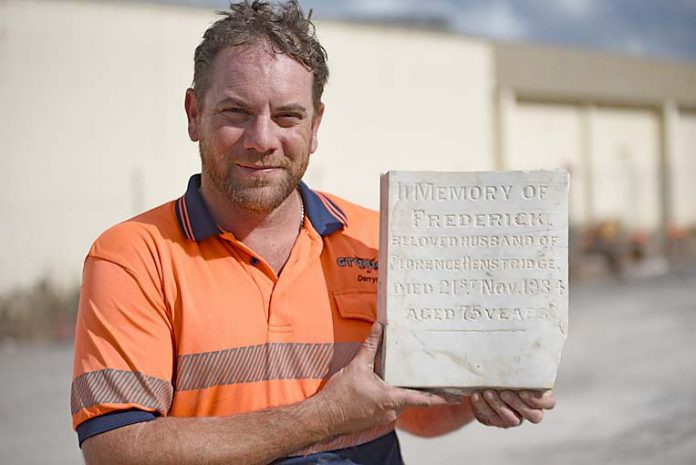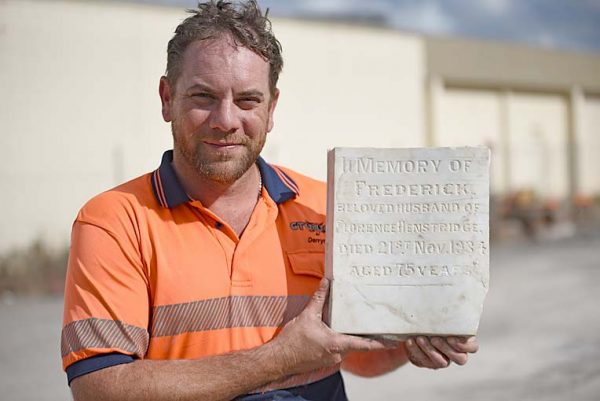

DEMOLITION worker Darryn Cole noticed a glimpse of an object in stone rubble while working in his excavator at the Fidler and Webb site.
Jumping out of his machine, nestled in the stone rubble was a marble plaque.
The plaque reads: “In Memory of Frederick, beloved husband of Florence Henstridge, died November 21, 1934, aged 75.”
The marble plaque, along with a hidden time capsule, are the only historical pieces that have been unearthed during the demolition works.
Speaking to The Border Watch this week, Mr Cole – from GT Bobcat – said he was surprised to find a plaque in an old stone wall section on the sprawling site.
“We were demolishing one of the stone walls – the plaque sort of popped up at the top. I thought ‘what is that’?” he said.
Mr Cole – who was unsure whether the plaque was inside or outside of the wall – said it was great to salvage a piece of history from the site.
Mount Gambier History Group president Phil McInnes said mystery surrounded why the plaque was at Fidlers and it was not known if there was any specific connection with the store.
While the truth was likely “never be known”, he said it could had been burial plaque that was left gathering dust at the store.
“It could had been packed away and forgotten,” Mr McInnes said.
He said the owners of the plaque could had taken it to Fidlers to have it repaired.
“We do not know whether the plaque – which was broken when it was found – was broken by the excavators or was taken to the store to be repaired,” Mr McInnes said.
He said the plaque would be kept in the history group’s historical archives.
It is understood there are a number other similar gravestone book style plaques at the Lake Terrace Cemetery.
The iconic Fidler and Webb site is steeped in history given it grew from humble beginnings into the state’s largest country general store.
Retail pioneers Caleb Fidler and Samuel Titus Webb – who were brothers-in-law – arrived in Mount Gambier about 150 years ago to open a grocery and general store.
The long lasting partnership remained until Mr Fidler’s death in 1874. Mr Webb continued as sole proprietor until his death in 1911.
The business was then purchased by a syndicate of local residents in 1912, which retained the business name.
The public were invited to take up shares and John Watson was appointed the first chairman who joined directors Mr A.B. Sinclair, J.U Innes, F.W. Pegler and Alex Haig.
It was a completely new enterprise for these first directors and they had plenty of worries on their hands due to the lean times during World War I.
At this time, Australia was still getting most manufactured goods from overseas suppliers.
Despite the difficult economic climate and the instability of war, the Fidler and Webb Store continued to evolve and grow.
The premises was altered and extended, electric lights were installed and motor transport was used for deliveries.
Fidler and Webb evolved into a premier “country general store”.
Despite the store being rocked by the worldwide economic depression in 1931, the directors made a “momentous” decision to rebuild the premises and give the Mount Gambier a “modern
emporium”.
The new store, under the management of Mr S.W. Worthley, attracted more and more business and within a few years the store was prospering.
Continually evolving to reflect consumer demand, Mr G.J. Ascione was appointed manager in 1952 until his retirement.
In 1985, the company was subject to a takeover bid by interstate company J. Richardson and Co.
South East Telecasters Ltd made a counter offer to purchase the whole or part of the shareholding in Fidler and Webb and were successful in gaining control.
A new board of directors were appointed under the chairmanship of Allan Scott who quickly implemented a financial reconstruction of the company to renovate and upgrade the store.
The last tenants moved out in 2013 after the site was purchased by Melbourne based developer GLG.





